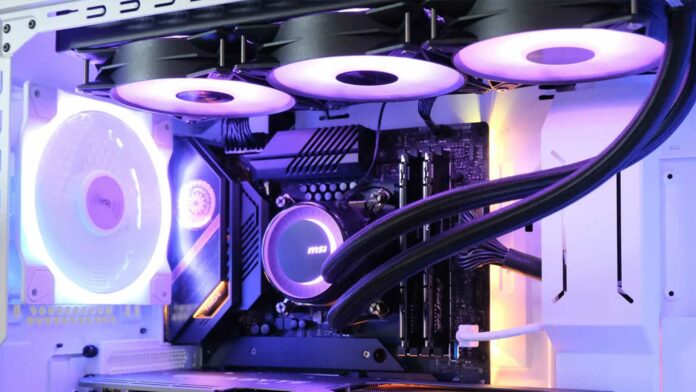Club386 endorses products based on our extensive tests and experience. If you make a purchase using our referral links, we may get a small commission at no extra cost to you.
You’ll want the best CPU cooler by your side when the heart of your gaming PC starts heating up. Much like the human body, the more you push your processor, the more it works up a sweat. Let it get too toasty, and you could see your PC shut down, or you might even shorten its lifespan. A good CPU cooler keeps those temperatures at bay and stops it from overheating. Not just any old blower will do the trick. To choose the right one for the job, you first need to know air cooling from your AIO liquid cooling.
Air coolers do what they say on the tin. Using a metal heatsink, they sap the warmth away from the best CPU, then cool it with air using connected fans. On the plus side, air coolers are the most affordable solution, and they’re great for mid-range processors. Unfortunately, they struggle with the temperatures of higher-end models like Intel Core i9 or AMD Ryzen Threadripper.
Liquid coolers use fluid to transfer the heat from your chip. It travels from a water block through tubes to the connected radiator, where fans handle cooling. This method used to be reserved for DIY enthusiasts building fully watercooled rigs. The rise in AIO (all-in-one) solutions has made it far more accessible. It’s ideal for overclocking and high-end CPUs, but you’ll pay a little more for the pleasure.
Once you know which type you want, it’s especially important to consider space. Most air coolers are bulky, and you’ll need to be mindful of their height. AIO coolers are significantly shorter and instead have a bulky radiator that’s best placed at the front or top. You’ll need to note your PC case dimensions or whip out the tape measure to be sure. Don’t worry about whether you prefer Intel or AMD. Our tried and tested CPU coolers have brackets for all kinds of sockets.
At a glance
- MSI MAG CoreLiquid E360 – best CPU cooler
- be quiet! Dark Rock Elite – best silent air cooler
- Arctic Freezer 36 – best budget air cooler
- Noctua NH-D15 G2 – best Noctua cooler
- DeepCool LT720 WH – best looking AIO
- be quiet! Light Loop 240 – best RGB cooler
- be quiet! Pure Loop 2 – best 280mm AIO
- Arctic Liquid Freezer III 420 ARGB – best 420mm AIO
Best coolers for CPUs
MSI MAG CoreLiquid E360
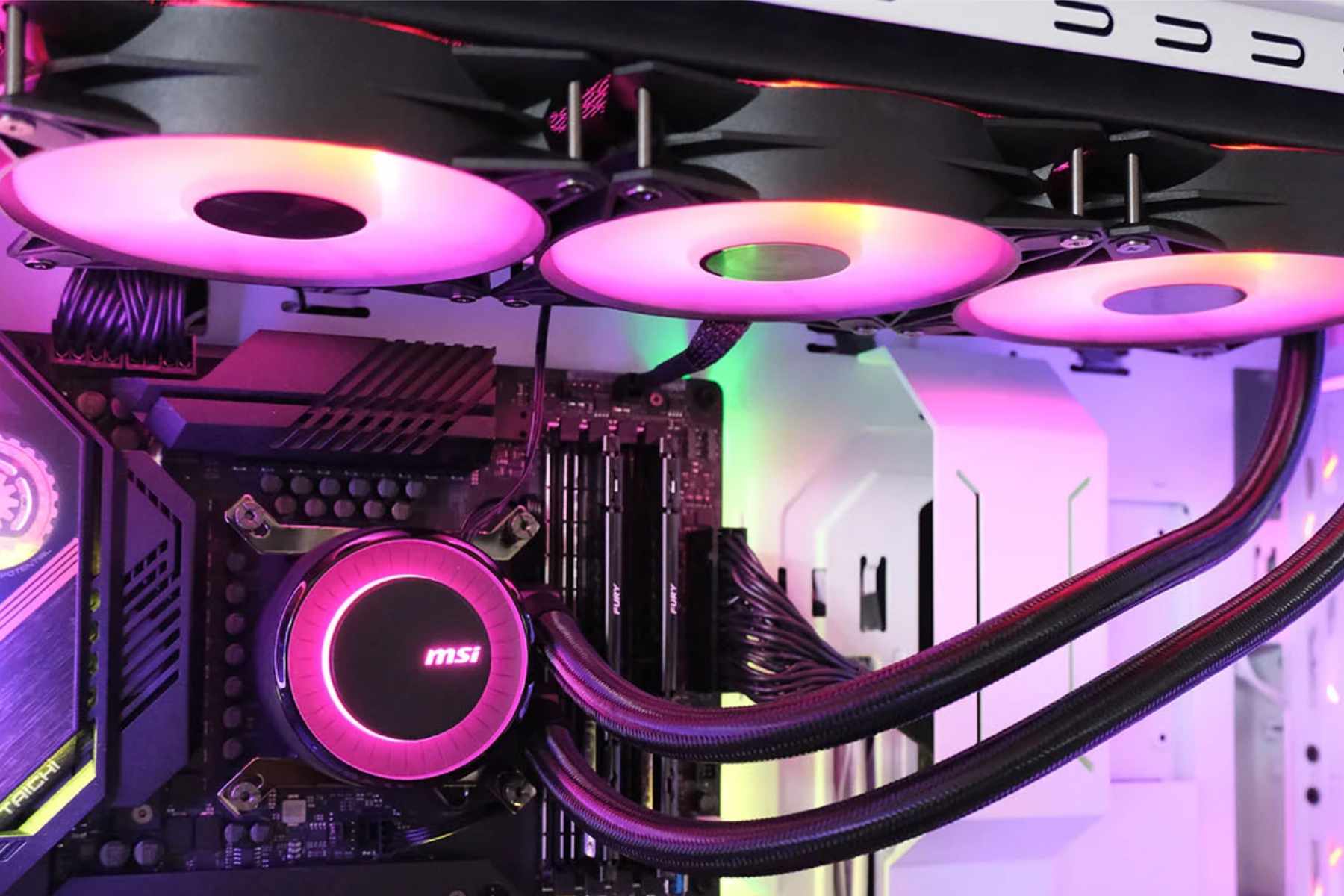

Pros
- Enthusiast-grade cooling
- Comes in black or white
- Spare paste included
- Quiet pump and RGB fans
Cons
- No 280mm model
- Fans noisy at high speed
Club386 may earn an affiliate commission when you purchase products through links on our site.
How we test and review products.
The best CPU cooler.
Our top cooler was always going to be an AIO, given liquid cooling offers unrivalled performance. If you’ve ever splashed your face with water to cool yourself down, you know how effective it can be. The MSI MAG CoreLiquid E360 stands out above the rest, with the best temperatures and performance in most of our tests, especially at a higher TDP.
Using the Intel Core i9-13900K at 153W, the MAG CoreLiquid E360 consistently managed to stay cooler with the fans spinning at a lower rpm. There are a few AIO CPU coolers out there with a higher max rpm that lop a degree or two off, but we prefer our gaming PC stealthy rather than sounding like a helicopter. It even managed to keep a cool enough head at 253W, below the 90°C mark.
It’s not all function, though, as it also looks the part. Coming in both black and white, it features a sleek RGB-driven faceplate. Take a peek at an angle and it looks a little like a glowing crescent moon. We’re big fans. Speaking of which, the blowers include white blades to better reflect the lighting, transforming the radiator from a slab of metal into something a bit more fetching.
Even the price point is pretty slim for a cooler of this capacity: £94.99 for the dual-fan E240 and £119.99 for the triple-fan E360. It’s a shame there’s no E280 for 140mm fans, but it doesn’t get much better than this.
Read our full MSI MAG CoreLiquid E360 review here.
| MSI MAG CoreLiquid E360 specs | |
|---|---|
| Fans | x3 Cooler Master FD12025L12SPAA 120mm |
| Fan speed | Up to 1,800rpm |
| Noise | Up to 52.6dBA |
| Radiator size (L x W x H) | 394 x 119.2 x 27mm |
| Supported sockets | Intel: LGA 1851 LGA 1700 LGA 1200 LGA 1156 LGA 1155 LGA 1151 LGA 1150 AMD: AM5 AM4 TR4 sTRx4 |
| MSRP | From $140 / £120 |
be quiet! Dark Rock Elite
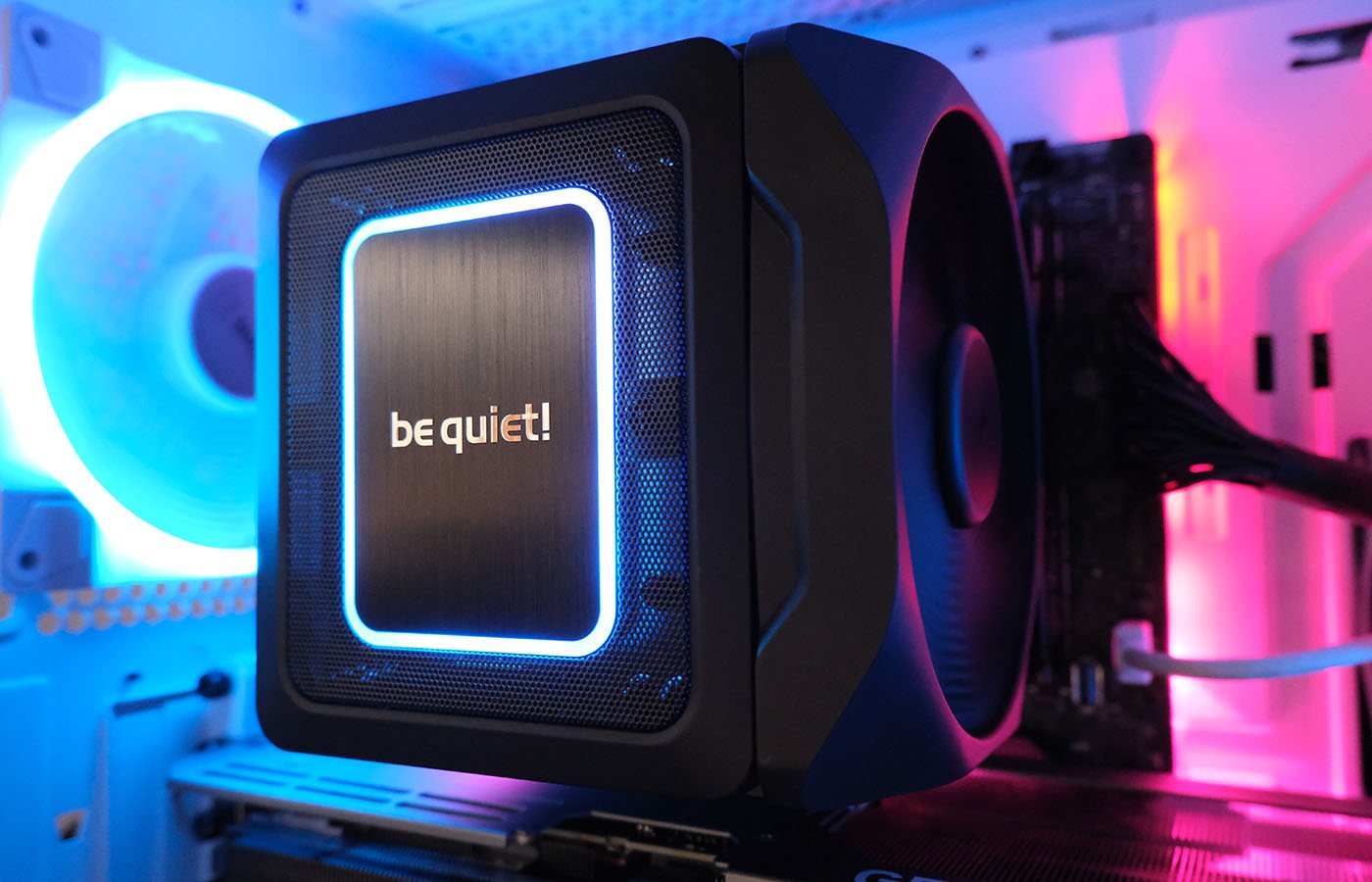

Pros
- Ideal for potent, quiet PC
- Near silent at low speed
- Elegant RGB lighting
- Simple installation
- No fiddly fan clips
Cons
- Struggles with Core i9
- Basic bundle and warranty
Club386 may earn an affiliate commission when you purchase products through links on our site.
How we test and review products.
The best quiet air cooler.
be quiet! Dark Rock Elite lives by its name, keeping acoustics hush. Single-tower options are usually more muted, but two premium 135mm Silent Wings PWM fans are better than one. It’s the quietest dual-tower we’ve tested with a Core i9-13900K, which is no small feat. All the best air coolers struggle with Intel’s beast.
When the gaming gets tough, performance mode is on-hand to crank the fans up to their maximum 2,000rpm. Toggling quiet mode resets them back to 1,500rpm, all without having to head into BIOS. It’s a luxury-level of control that means you can scale depending on the balance you want. It’s a little shy of Noctua’s most performant CPU coolers, running 2.4% hotter, but it’s up to 14.9% quieter. That’s a trade-off we’re personally willing to make.
Dual-tower air coolers have a nasty habit of looking a bit unwieldy with their bulk. Dark Rock Elite sidesteps this with an attractive RGB-covered black mesh shroud. It still sits pretty close to the tempered glass panel on your PC case with a 168mm height, but it doesn’t dominate. It’s one you’ll be proud to showcase on your desk.
The high-end air cooler isn’t cheap, costing you triple figures. You get what you pay for, however, which is a hassle-free setup, sleek look, and whisper-quiet performance. It’s the ideal air cooler for anything other than the most demanding processors.
Read our full be quiet! Dark Rock Elite review.
| be quiet! Dark Rock Elite specs | |
|---|---|
| Fans | 2x be quiet! Silent Wings 135mm |
| Fan speed | Up to 2,000rpm |
| Noise | Up to 41.8dBA |
| Size (L x W x H) | 145 x 136 x 168mm |
| Supported sockets | Intel: LGA 1851 LGA 1700 LGA 1200 LGA 1155 LGA 1151 LGA 1150 AMD: AM4 AM5 |
| MSRP | From $115 / £110 |
Arctic Freezer 36
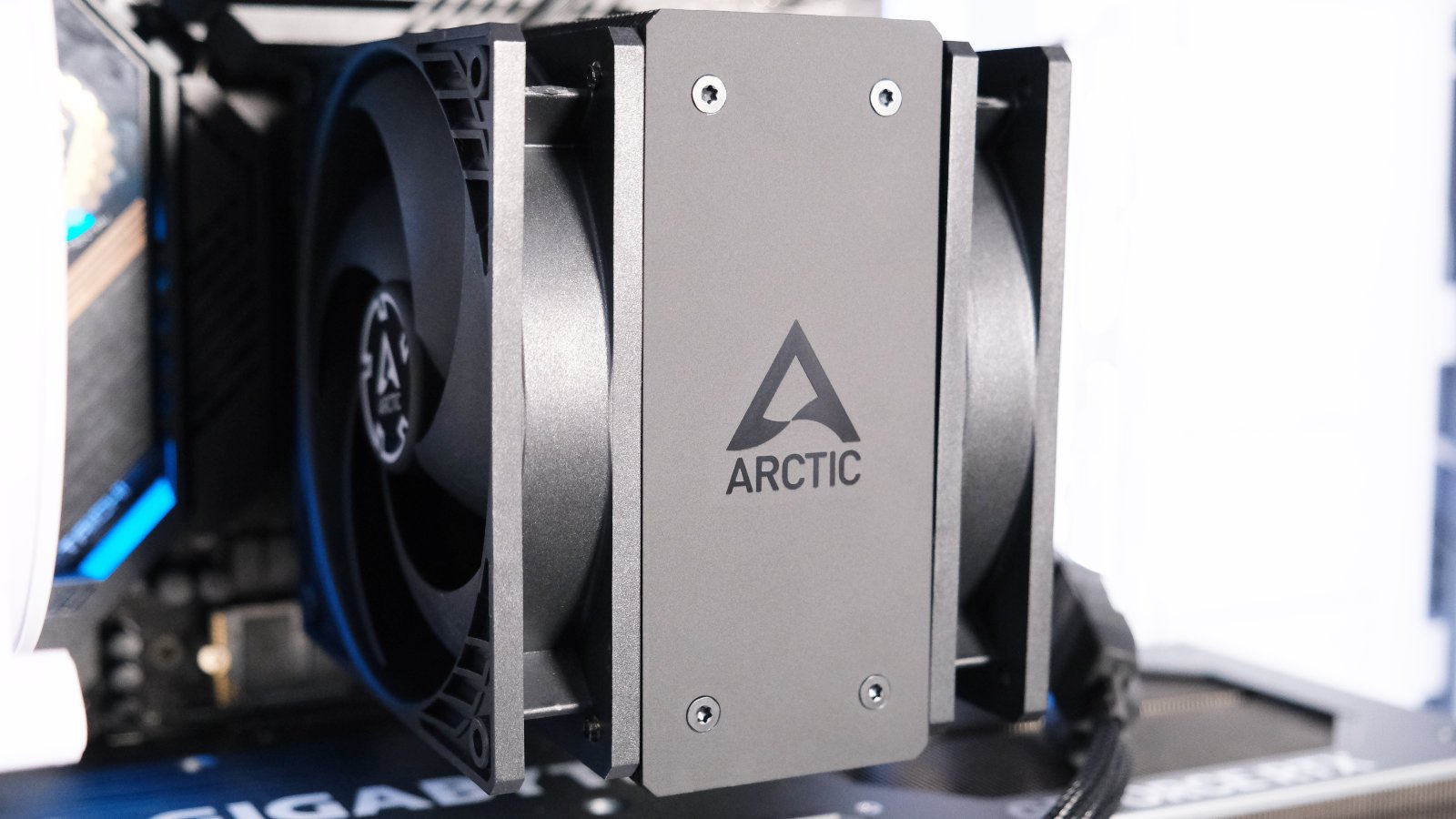

Pros
- Amazing value
- Launch day discount
- 6-year warranty
- Simple installation
Cons
- Clip mounts need work
- Lacks older Intel support
Club386 may earn an affiliate commission when you purchase products through links on our site.
How we test and review products.
Best budget air cooler.
Proving that good coolers don’t need to cost the earth, Arctic Freezer 36 set the bar as low as £30 / $30 back when it launched in March 2024 and it’s only gotten more affordable as the months roll by. Hunt around a bit and you can grab it for a paltry £17, leaving tons of wiggle room in the budget for the processor itself.
For your pennies, you get two P12 PWM PST 120mm fans to clip onto either side of the dual tower in perhaps the simplest mounting mechanism I’ve used to date. Each fan runs up to 1,800rpm but its Zero RPM feature means the fans won’t budge if CPU load is below 5%, keeping it whisper quiet when idle.
You can get the device in five unique looks, from the original black and silver, to a CO version for continuous operation, and ARGB designs in either black or white. I might be biased, but my favourite is the jet black model I took a peek at, giving it a stealthy look that fits into almost any build.
There’s no denying the cooler is better suited to Intel i7 and below or a more efficient AMD Ryzen chip rather than the Core i9-13900K I tested it with, but Freezer 36 still handles the beast like a champ, especially for the price. It toes the same line as Dark Rock Elite with temperatures albeit not quiet as effectively at an average of 153W. Still, 8% higher temps for 80% of the cost is more than a fair bargain.
Read our Arctic Freezer 36 review.
| Arctic Freezer 36 specs | |
|---|---|
| Fans | 2x P12 PWM PST 120mm |
| Fan speed | Up to 1,800rpm |
| Noise | Up to 41.1dBA |
| Size (W x H) | 126 x 159mm |
| Supported sockets | Intel: LGA 1851 LGA 1700 AMD: AM5 AM4 |
| Price | From $30 / £30 |
Noctua NH-D15 G2
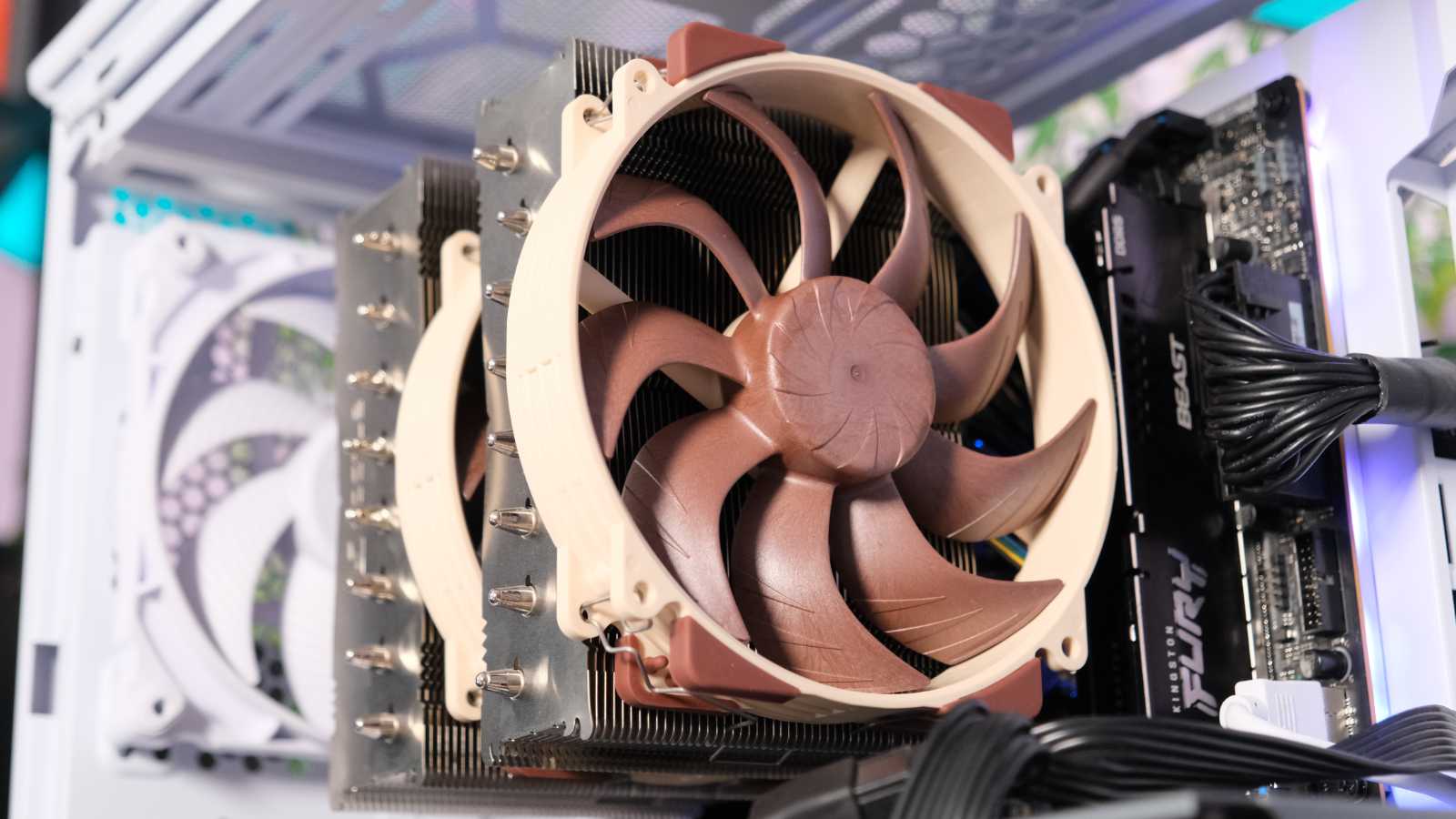

Pros
- Exceptional cooling
- Great CPU support
- Adjustable fan height
- Simple installation
- 6-year warranty
Cons
- Pricey
- No chromax.black model yet
Club386 may earn an affiliate commission when you purchase products through links on our site.
How we test and review products.
The best Noctua has to offer.
Fans of the iconic beige and brown blowers can rejoice, as Noctua has finally launched its long-awaited second-generation NH-D15 G2 coolers after ten years in the making. I say coolers plural because there are three different flavours to choose from depending on which CPU you plan on placing it over: HBC (high-based convexity) for the higher hot spots on Intel chips, LBC (low-based convexity) best suited to AMD Ryzen’s flatter approach, and a standard model that’s the safe option just in case you can’t decide.
No matter which you choose, you get the same superbly-built dual tower with eight heatpipes (up from six on the first edition) and two NF-A14x25r G2 fans doing the heavy lifting. Much of the engineering focuses on the latter, reducing the spacing between each blade to 1.6mm and placing each just microns away from the casing, resulting in a fantastic 155.6m³/h of airflow at 1,500rpm. There aren’t many air coolers that compete at this level.
Granted, these blades can get louder at up to 47.3dBA when allowed to run as fast as they’ll go, but such is the nature of full-speed 140mm fans. With a decent fan curve, even a PC under load will regularly sit under that coveted 30dBA mark that Noctua promises. At idles, you’ll practically never hear it running.
We’re still waiting on a potential chromax.black edition and you can forget about RGB lighting, but Noctua’s signature colour scheme signifies quality to everyone who gazes over. It’s even primed and ready with some of the widest socket compatibility, from tried-and-true LGA 1150 through to the latest LGA 1851.
Read our full Noctua NH-D15 G2 review.
| Noctua NH-D15 G2 specs | |
|---|---|
| Fans | x2 NF-A14x25r G2 140mm |
| Fan speed | Up to 1,500rpm |
| Noise | Up to 47.3dBA |
| Size (L x W x H) | 127 x 150 x 168mm |
| Supported sockets | Intel: LGA 1851 LGA 1700 LGA 1200 LGA 1156 LGA 1155 LGA 1151 LGA 1150 AMD: AM5 AM4 |
| MSRP | From £128 / $150 |
DeepCool LT720 WH
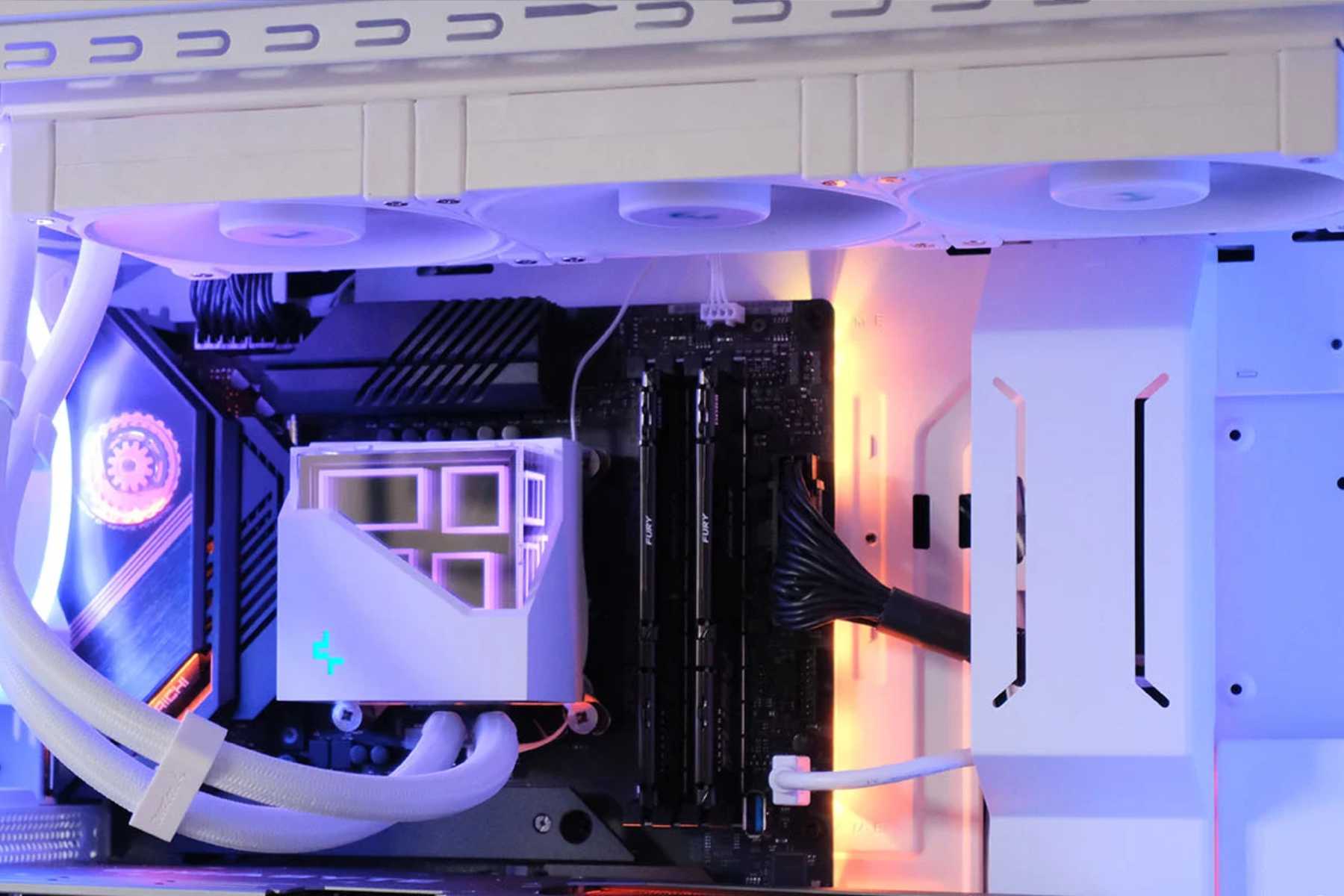

Pros
- Enthusiast-grade cooling
- Comes in black or white
- Awesome retro design
- Simple installation
- Five-year warranty
Cons
- No spare thermal paste
- No 280mm option
Club386 may earn an affiliate commission when you purchase products through links on our site.
How we test and review products.
The best-looking CPU cooler.
DeepCool LT720 is a prime example of not always being a choice between form or function. You can have both, and shouldn’t let anyone tell you otherwise. It’s also a testament that less is more in the ARGB department, sticking with block-coloured fans and relegating any glowing bits to the CPU block.
You have a choice between black or white. We’re partial to the bleached model, given its clean look and the contrast of black and white in the waterblock. The original model stands out itself, though, with a grey block instead. Ultimately, this will depend on your gaming PC setup, but it’s nice to have a choice.
LT720 is the third-best CPU cooler we’ve tested in Cinebench, using a Core i9-13900K at 253W. There’s a bit of a trade-off with noise when the fans are full pelt at 2,300rpm, but DeepCool’s blades also spin quicker than any others on this list. Clocking in at a more reasonable 1,200rpm, it’s around 4dB quieter than our MSI top pick.
Overall, it’s one of the most compatible CPU coolers we’ve tried. It features brackets for most Intel processors over the past 15 years. AMD support is a bit spottier, focusing on AM4 onwards, so your mileage may vary. Still, for the price you pay, it’s a jack-of-all-trades that looks the part in any system.
Read our full DeepCool LT720 WH AIO review here.
| DeepCool LT720 specs | |
|---|---|
| Fans | 3x 120mm |
| Fan speed | Up to 2,250rpm |
| Noise | Up to 53.3dBA |
| Radiator size (L x W x H) | 402 x 120 x 27mm |
| Supported sockets | Intel: LGA 1851 LGA 1700 LGA 1200 LGA 1156 LGA 1155 LGA 1151 LGA 1150 LGA 2066 LGA 2011-v3 LGA 2011 AMD: AM5 AM4 sTRx4 sTR4 |
| MSRP | From $140 / £130 |
be quiet! Light Loop 240
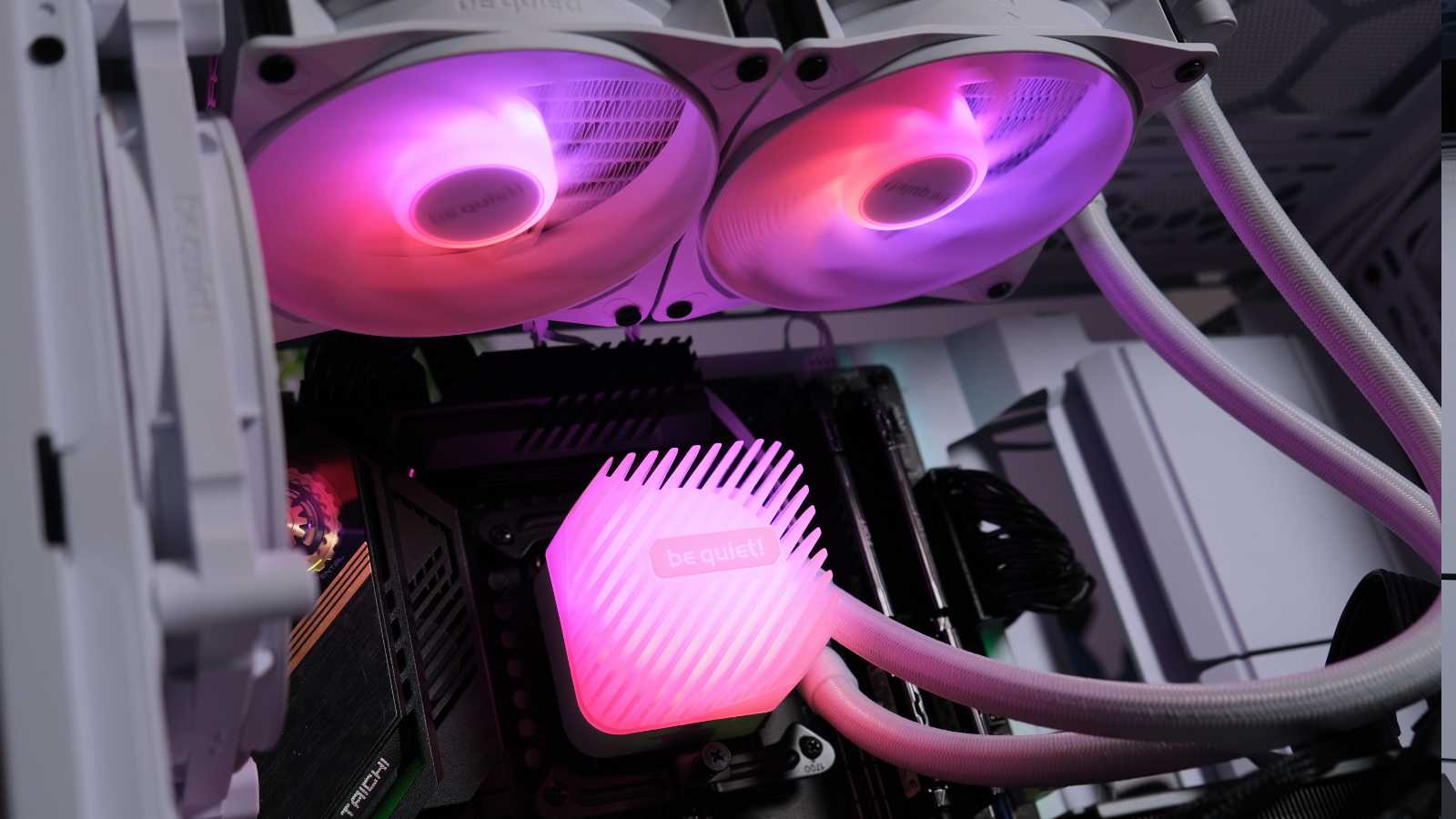

Pros
- Jaw-dropping RGB lights
- Refillable with extra coolant
- ARGB hub included
- Black or white options
- Wonderfully chill
Cons
- No 280/420 models
- Fixed logo
Club386 may earn an affiliate commission when you purchase products through links on our site.
How we test and review products.
The best RGB cooler money can buy.
Rather than rapidly entering the RGB race like most manufacturers, be quiet! took its sweet time and my, oh my, does it pay off. The sum of all its parts, Light Loop 240 makes one heck of a first impression thanks to a gorgeous frosted pump and vibrant Light Wings LX 120mm fans that spread the colour across all its nine blades.
I can’t speak so much for the black model, but there’s no better base coat than white when it comes to enhancing the glow of RGB LEDs. Pair this with an included fan hub, which synchronises up to six devices (PWM and ARGB connectors included), and it’s the ultimate bundle for anyone looking to add more than a dash of colour into their system.
Marrying form with function, be quiet! has prepared its Light Loop range with a series of tweaks under the hood. The pump is entirely new with a progressive integrated circuit to keep noise levels especially low, while the redesigned jet plate and cold plate specifically target Ryzen 9 and Core i9 chips. Usually, a 240mm wouldn’t be my go-to for a 14900K, but it’s such a sight to behold that it became my personal rig’s main AIO cooler for the rest of 2024. It hasn’t missed a beat yet.
One benefit of sticking with be quiet! is that it’ll likely be the last cooler you’ll need for a good, long while. Light Loop includes a refill port and packs a spare bottle of coolant in the box, so when your AIO starts to lose its buzz, you can simply top it up and get back to peak performance. It’s peace of mind like no other, and makes it cost-effective in the long run.
Read our be quiet! Light Loop 240 review.
| be quiet! Light Loop 240 specs | |
|---|---|
| Fans | x2 Light Wings LX high-speed 120mm |
| Fan speed | Up to 2,100rpm |
| Noise | Up to 46.2dBA |
| Radiator size (L x W x H) | 277 x 120 x 52mm |
| Supported sockets | Intel: LGA 1851 LGA 1700 LGA 1200 LGA 1155 LGA 1151 LGA 1150 AMD: AM5 AM4 |
| MSRP | From $130 / £120 |
be quiet! Pure Loop 2
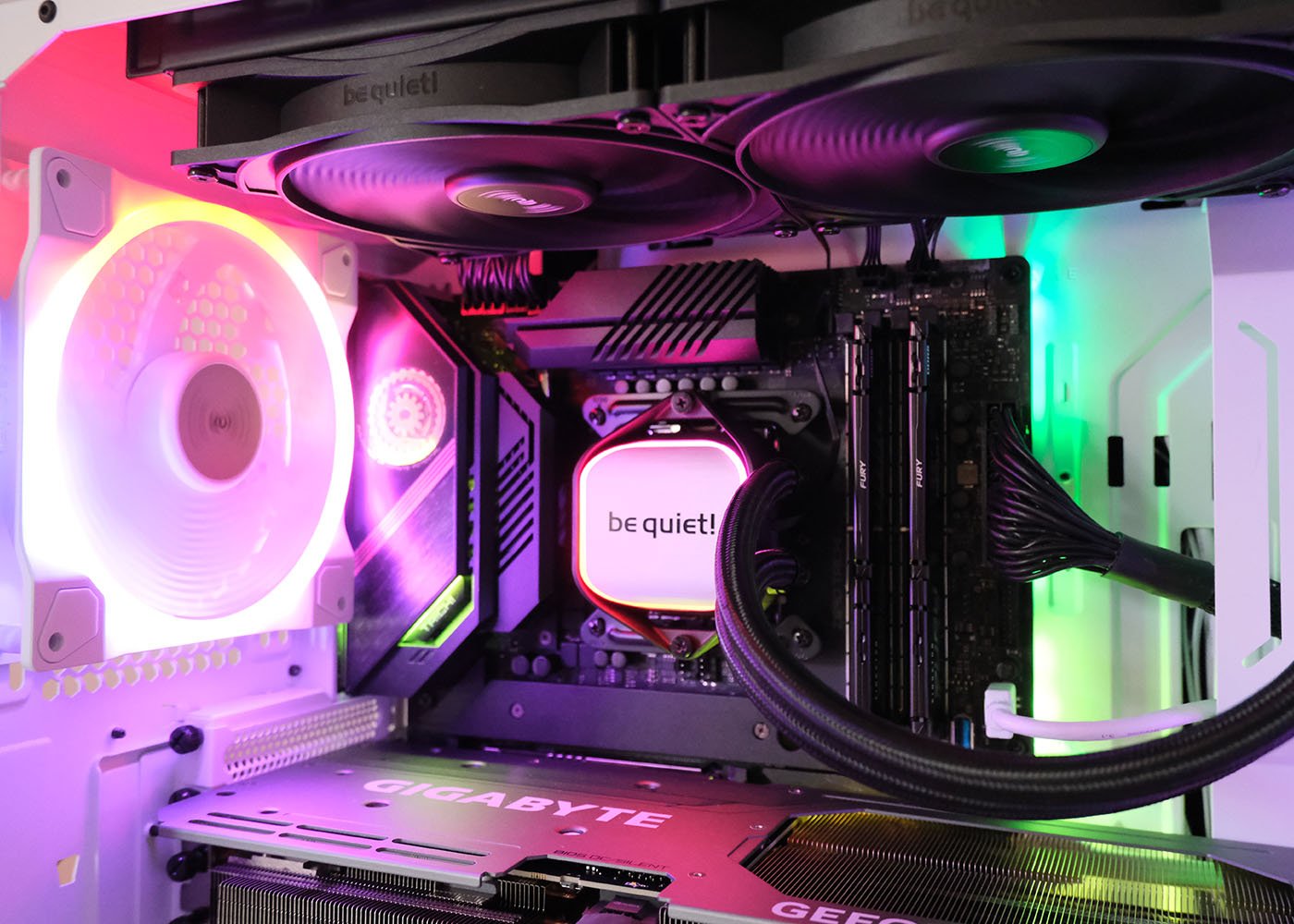

Pros
- Minimalist design
- Can tame an i9-13900K
- Spare paste and coolant
- Simple installation
- Pure Wings 3 fans
Cons
- No 420mm option
Club386 may earn an affiliate commission when you purchase products through links on our site.
How we test and review products.
The best 280mm AIO cooler.
Credit where it’s due; be quiet! caters to a wide market. Not only does Pure Loop 2 start with a 120mm option despite dinky devices falling out of favour, but there’s also a fantastic 280mm model for larger fans. Sure, there are 240mm and 360mm choices too, but they’re a dime a dozen.
The biggest benefit of a 280mm model is that you can slip 140mm fans in. You don’t need as many of them to push the same amount of air, and they can spin slower. In our how to make a PC quieter guide, we describe them as essential if your goal is a silent system.
As its second generation of mid-range CPU coolers, Pure Loop 2 swaps white LEDs for ARGB, makes the pump PWM adjustable, and upgrades fans to the latest high-speed Pure Wings 3. There’s also a Pure Loop 2 FX model with Light Wings fans instead, if you want something a bit brighter.
You won’t notice much of a perceptible difference in performance between most AIO coolers on this list. You will hear a difference, however, which is where the Pure Loop 2 excels. Combine silence with a small starting price and be quiet! has gotten CPU coolers down to a fine art.
Read our full be quiet! Pure Loop 2 review.
| be quiet! Pure Loop 2 specs | |
|---|---|
| Fans | Up to three 120mm |
| Fan speed | Up to 1,800rpm |
| Noise | Up to 46dBA |
| Radiator size (L x W x H) | 277 x 120 x 27mm (52mm incl. fans) |
| Supported sockets | Intel: LGA 1851 LGA 1700 LGA 1200 LGA 1155 LGA 1151 LGA 1150 AMD: AM5 AM4 |
| MSRP | From $105 / £85 |
Arctic Liquid Freezer III 420 ARGB
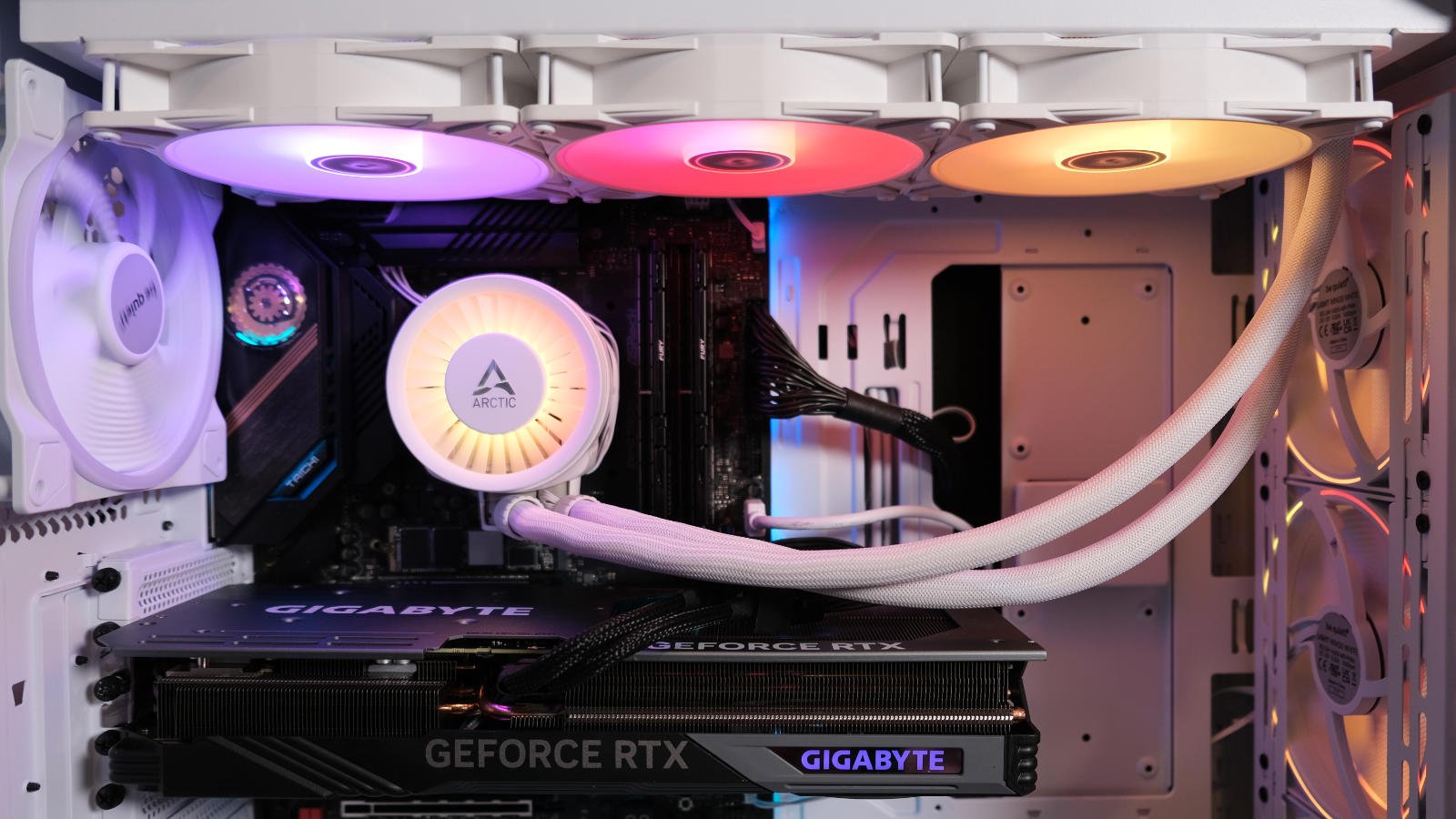

Pros
- Chart-topping thermals
- Incl. leading thermal paste
- Beautiful RGB, no software
- Fantastic launch price
- Six-year warranty
Cons
- Short PWM cables
- Can’t rotate faceplate
Club386 may earn an affiliate commission when you purchase products through links on our site.
How we test and review products.
The best 420mm AIO cooler.
Not many PC cases can squeeze in a chonky 420mm radiator. If yours can, then I can’t recommend Arctic Liquid Freezer III enough. It features a wonderfully revamped design for the third generation that’ll look at home in any build. There’s quite literally something for everyone here. You have the choice between black or white with ARGB or plain black with no lighting at all and across a range of sizes.
The 420mm model is our highlight. No other cooler has stood up to the power-hungry Intel Core i9-13900K like Liquid Freezer III 420, keeping the processor steadily under 80ºC while running at a full 253W. This is mainly thanks to three 140mm fans, although the industry-leading MX-6 thermal paste surely helps.
Liquid Freezer III remains one of the quieter models we’ve tested despite featuring so many chonky fans. It’s whisper-quiet when spinning slowly, rivalling that of air coolers. Ramping it up to full speed even gives be quiet! a run for its money.
There’s quite simply a lot to love here. You don’t need extra software for the RGB. It has unrivalled temperatures for high-end CPUs. And the best part is that Arctic launched it at a discount.
Read our full Arctic Liquid Freezer III 420 ARGB review.
| Arctic Liquid Freezer III specs | |
|---|---|
| Fans | Up to three 140mm |
| Fan speed | Up to 1,900rpm |
| Noise | Up to 46dBA |
| Radiator size (L x W x H) | 458 x 138 x 38mm |
| Sockets supported | Intel: LGA 1150 1151 1155 1200 1700 2011-v3 2066 AMD: AM4/AM5 |
| MSRP | From $99 / £130 |
Which CPU cooling is best?
Liquid coolers are the best devices to keep a CPU chilled. This can be an open loop, like custom watercooled systems, or a closed loop, such as AIO coolers. Air coolers do a good job at moving the heat away from the processor, but liquid can simply move more quickly. Besides, air cooling comes with the risk of raising the ambient temperature of the PC, which isn’t too bad for general gaming but becomes problematic when cranking the settings up.
Do AIO coolers leak?
No technology is perfect. There’s an inherent risk, albeit tiny, that closed-loop systems might spring a leak. Just as a car tyre might suffer a puncture, the risk of an AIO cooler stems from its very design – a symphony of pumps, tubes, and liquids working in harmony to siphon away the heat. This is why it’s important for you to buy from manufacturers that put their coolers through rigorous quality assurance testing. We’ll only recommend devices that are reliable and are bolstered with a warranty, just in case.
If you do spot the signs of a leak, take swift action:
- Power down the system – pull the emergency brakes and shut your PC down fully without hesitation.
- Disconnect the power supply – remove the kettle lead from the back of the PC. This is crucial to avoid short-circuiting.
- Find the leak – spot where the drip is so you can patch it. This stops you from further damaging the system when removing it.
- Carefully remove the AIO – ground yourself and pull the AIO from your PC.
- Inspect the damage – don your detective hat and investigate to see if any component is wet.
- Dry your system thoroughly – gently dry your components with a lint-free cloth and leave them a couple of days just in case.
- Test components individually – once dry, test each component separately where possible. Start with the motherboard, then try with the CPU, RAM, then graphics card.
- Contact the manufacturer – reach out to the brand’s support, present your claim, and use your device’s warranty.
Is AIO quieter than air?
AIO coolers are generally quieter than air coolers at idle speeds. Liquid stays cooler for longer, and the fans on the radiator shouldn’t start spinning until things start heating up. AIO coolers can be louder than air coolers when gaming, however, as the radiators often pack more fans, and there’s the sound of the pump. Ultimately, it depends on the rpm of the fan and how far you crank those fan curves.


